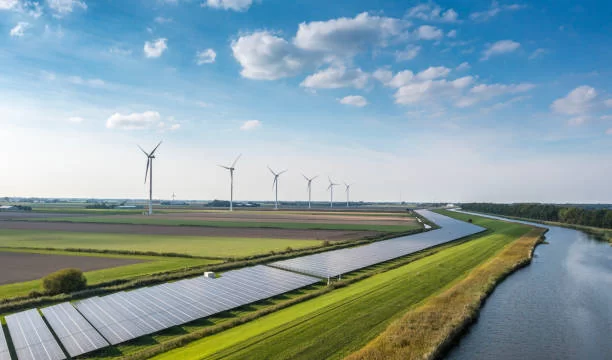Wind Turbine Power Plants Enhancing Energy Supply Stability
Against the backdrop of global energy transition, wind power plays an increasingly crucial role as a clean and renewable energy source. However, the intermittency and uncertainty of wind pose significant challenges for ensuring stable energy supply in wind turbine power plants. This article explores various approaches through which wind turbine power plants address this issue and enhance energy supply stability.
Layout and Site Optimization of Wind Farms
A rational layout and optimized site selection form the foundation for improving energy supply stability. During site selection, professional meteorological data and geographic information systems assess potential sites’ wind resource characteristics, including long-term wind speed, directional variability, and terrain impact on wind. For instance, choosing areas with stable wind patterns, such as coastal regions, mountain passes, or plateaus, typically ensures more stable and robust wind resources.

Layout and Site Optimization of Wind Farms
A rational layout and optimized site selection form the foundation for improving energy supply stability. During site selection, professional meteorological data and geographic information systems assess potential sites’ wind resource characteristics, including long-term wind speed, directional variability, and terrain impact on wind. For instance, choosing areas with stable wind patterns, such as coastal regions, mountain passes, or plateaus, typically ensures more stable and robust wind resources.
Furthermore, optimizing the layout of multiple wind turbines can enhance overall generation stability. Strategies like staggered arrangement and different height settings reduce mutual interference between turbines, ensuring that some turbines operate efficiently under varying wind conditions and smoothing out overall power output.
Application of Energy Storage Technologies
Energy storage systems are pivotal in addressing the intermittency of wind power generation. Equipping wind turbine power plants with battery storage systems, supercapacitor energy storage systems, or pumped hydro storage systems allows surplus electricity generated from wind to be stored and released during periods of low wind or calm conditions, thereby achieving stable power output.
For example, with battery storage systems, excess electricity generated during strong winds can be stored in batteries. Conversely, when wind speeds decrease and electricity generation declines, batteries discharge to supplement grid demand. Additionally, emerging technologies such as flow batteries and flywheel energy storage are continually being developed and deployed, providing more options to enhance wind power generation stability.
Smart Monitoring and Forecasting Systems
Advanced meteorological monitoring equipment and data analytics algorithms establish intelligent wind monitoring and forecasting systems. By continuously monitoring parameters such as wind speed, direction, air pressure, and temperature, combined with historical data and weather forecast models, these systems predict wind power generation output over a future time period.
Based on accurate forecasting results, power dispatch departments can preemptively devise generation schedules and deployment strategies, effectively coordinating wind power generation with other energy sources to ensure energy supply stability. Additionally, real-time monitoring systems promptly detect turbine faults and anomalies, enabling timely maintenance and reducing downtime due to equipment failures.
Multi-Energy Complementary Systems
Integrating wind power generation with other forms of energy forms effective multi-energy complementary systems, further enhancing energy supply stability. For example, combining wind power with solar photovoltaic, hydroelectric, or biomass power forms wind-solar complementary, wind-hydro complementary, and wind-biomass complementary systems.
When wind power generation output fluctuates, other energy sources can quickly supplement, ensuring stable total power output. For instance, in regions where solar energy is abundant during the day and wind is stronger at night, wind-solar complementary systems ensure 24-hour stable electricity supply.
Technological Innovation and Equipment Upgrades
Continuous technological innovation and equipment upgrades are critical to improving wind power generation stability. For instance, developing wind turbine blades and generators with higher efficiency and broader wind speed adaptation ranges. Implementing smart control technologies enables turbines to automatically adjust blade angles, rotational speeds, and other parameters based on real-time wind conditions, optimizing power generation efficiency.
Additionally, enhancing turbine reliability and durability through advanced materials and manufacturing processes, coupled with regular maintenance and inspections, reduces equipment failures and enhances energy supply stability.
Grid Connection and Management Optimization
Optimizing grid connection methods and management strategies for wind turbine power plants is crucial for enhancing energy supply stability. Strengthening grid infrastructure, enhancing transmission capacity, and flexibility enable seamless integration of wind power generation into the grid.
Moreover, employing smart grid technologies facilitates real-time monitoring, dispatch, and management of wind power generation. Based on grid demand and actual wind power generation conditions, adjustments in generation output ensure safe and stable grid operation.
In conclusion, through comprehensive application of strategies such as layout and site optimization, energy storage technology application, smart monitoring and forecasting, multi-energy complementary systems, technological innovation and equipment upgrades, and grid connection and management optimization, wind turbine power plants effectively enhance energy supply stability. This contributes significantly to advancing global energy transition and sustainable development efforts.
